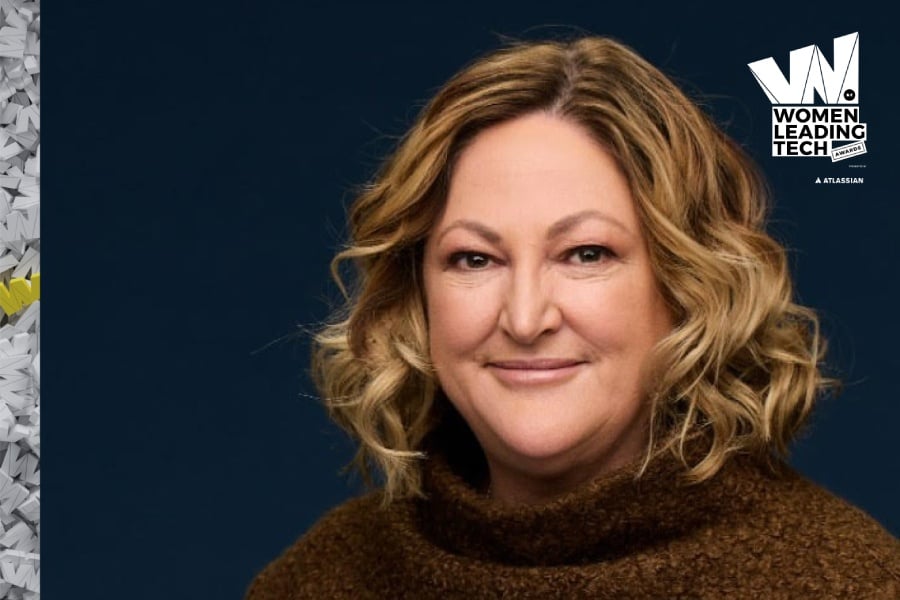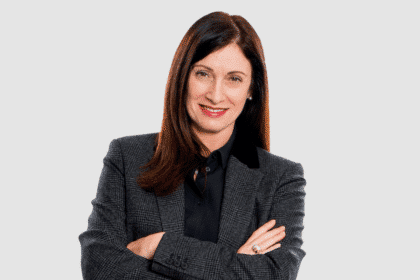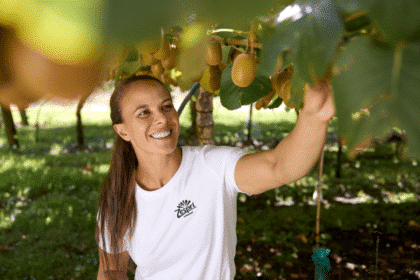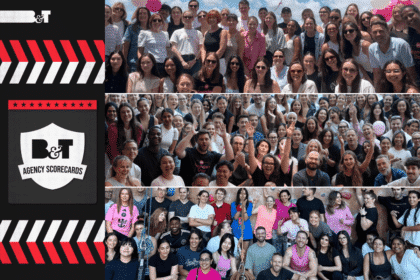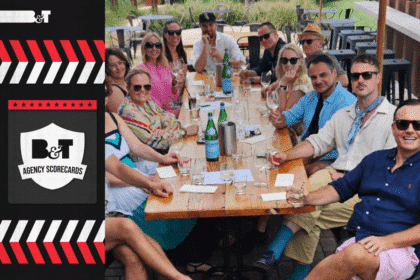Rebecca Haagsma, chief product officer at Nine, has had an enviable career in the world of technology and media.
From publishing B2B print and online titles in the mid-noughties to driving product innovation at Nine over two stints, she has been at the forefront of tech in Australian digital media.
However, as Haagsma made clear during our chat ahead of B&T’s Women Leading Tech Awards, she (has embraced her career, and her family equally and made this work) v ( never let being a woman hold her back) and she is focused on helping to champion the women she works with in any way she can.
B&T: How did you come to work in tech at Nine?
Rebecca Haagsma: It’s been a great journey. I was actually the publisher of B&T, many, many years ago!
I’ve built a career in transformation. I started working in traditional businesses – museums and print publishing, and hit them when they were transforming into digital distribution and publishing methods.
In the publishing world, I transitioned from a traditional editorial role into a digital role. I came to be involved not through formal training, but through digital transformation. In 2000, I started working for RBI (Reed Business Information), which was a global trade publishing business that was focused on ensuring a successful and fast transition into the digital world, and therefore created roles and KPIs to reflect that.
My career has transitioned through print, online and broadcast businesses and then to telco, building transformative businesses and leading product teams. My senior roles have been in the management and execution of a product division and a product strategy, both enabled by technology. I now run the product side of the Nine business, working alongside our tech organisation.
B&T: How have you seen the tech industry change over your career?
RH: Over my career, we’ve gone from pens and paper (yes, we were still doing print checks with red markers in hand) into completely technology-driven workflows, distribution and audience engagement. .
When I joined ACP Magazines as digital director, we were publishing our content using traditional methodologies and early CMS adoption, launching the first websites, off the print brands. Then we started adopting and embracing technology to reach audiences in a different way and on different platforms. That has been the real transformation. Like the ripples of Chat GPT right now, and any new tech, it’s technology that has enabled a way of publishing, distribution and audience engagement that we haven’t seen before and that gives us options to explore in our product thinking and strategy.
Equally, our audiences have driven that demand, as well. We’ve had to adopt technology to give consumers what they want, where they want.
B&T: How has the industry changed for women over your career?
RH: It’s been pretty interesting! I’ve definitely worked in the industry long enough to have been the only woman in the room many times – and still sometimes today. However, I’m seeing so many more women participating in the industry, leading the way, and having a voice in the room.
I’d also say that while ‘technology’ is one word, it embraces many different streams of work and creates opportunity – whether it’s data and analytics, cyber, backend or front-end dev, or UI design work, to name a few areas. There are so many different streams and opportunities for a diverse group of people to find an opportunity in, and to accommodate different skills and behaviours that collectively drive success.
I definitely feel that the recognition and embracing of women in tech — as you have through your awards — and transparency and visibility of women, their careers, the decisions and opportunities for work-life balance, has dramatically changed over the last decade.
That doesn’t mean that we’re there — more change is needed. But it is very different from, say, 20 years ago.
B&T: What has driven that change?
RH: If I think about my own personal experience — it’s visibility. You can’t believe it unless you can see it. The abstract is harder to grasp. And secondly, more flexible approaches to work, which is in turn enabled in part by technology.
Seeing – and hearing from – more women working in tech has a snowball effect that encourages more participation. I’ve got four daughters who have been through the school system and are now in the workforce, juggling motherhood and work, building careers and studying at uni (none in the STEM space though!) – I’ve seen the promotion of programmes and a focus on this at schools that didn’t exist when I went through school.
I also think about some of the leaders in technology who I’ve worked with – and for – over the years, and how focused they’ve been on driving and leading change in terms of a positive impact on culture, and diversity in the teams. Emerging talent, and new entrants to the workforce are equally as important and I find it super exciting to have a coffee and listen to their expectations and experiences as they start to build their career.
I hope as a society, we’re more educated about the benefits that diversity — of all kinds — brings. As that conversation continues to grow and amplify, we’ll see increasingly diverse teams and skill sets come into play.
B&T: You have had two stints at Nine. What changes have you seen within the organisation with regard to diversity and inclusion, as well as attitudes towards women in the tech side of the business?
RH: My first stint at Nine was through the ninemsn JV, and then into Nine Digital, when Nine was a broadcast TV business. Now, in my second stint, it is a broader set of businesses across the publishing, radio and television businesses.
We are very cognisant, as are most businesses today, with the need for a broad range of skills to produce results and to reach our audiences where we need to reach them. The platforms and the technology we need to embrace today are very different from 10 years ago.
When I last worked at Nine, I was leading the product team who envisaged, then built and delivered 9Now. The technology team I partnered with was led by a very talented senior leader, who is a female leader now in a very different industry. Across the product and technology teams, we had great participation in gender and cultural programs, and a workforce that represented something like 20 different cultural backgrounds, with strong female and male leaders in the mix.
This time around, we have a larger function as a whole, encompassing experts in data, identity, web and app products and development, streaming, video production, design and UI, commercial product integration, to build and run our digital properties for publications such as the Sydney Morning Herald, for radio across our portfolio — 2GB in the Sydney market, for 9Now, and for nine.com.au.
Today, our Women In Tech program is driven at the grassroots level by a couple of our female engineers – it is their program; and I would argue that its strength comes from being led from within the organisation. That is really powerful. The breadth of Nine’s audience, products and people, is really exciting and the opportunity to lead, influence and participate as a female executive has been a really rewarding part of my return to Nine. A number of leaders at Nine run mentoring programs for their teams and use their influence to match people up to encourage really strong mentor/mentee relationships in the business, a really positive and action-based approach.
The challenges remain here to be addressed by me and others as leaders, and to encourage transparency and openness about our organisation and the way our people and our leaders address issues like gender and age diversity, and is one which I’m embracing and glad to play a role in.
B&T: Why do you think Nine is perhaps not seen within the broader industry as a leader for having a diverse workforce? What can other organisations learn from Nine?
RH: I’m sure that many media and tech organisations have a reality that is perhaps different from the perception. My experience at Nine has always been a good one, and I’ve had great career opportunities and worked with a diverse set of people, however it’s clear that we have more work to do – there are areas of excellence and areas that need to grow and have challenges in this space. We will keep working on those areas in many different ways – recently, we’ve recently introduced communities, a new way of involving and engaging with each other around key values and culture – one of these communities is diversity, including gender. Employees self nominate to join the working group and together drive events and initiatives, with support from sponsors.
Nine is also a shareholder in Future Women, an organisation that helps women connect, learn and lead, and we offer different opportunities to our female workforce via Future Women. There is also a changemakers program offered by Future Women that is targeted towards men and several of our leaders have already participated in that program.
In terms of the second question, as I said before, ‘You have to see it to believe it.’ So we’re super-focused on the work we need to do here and reaching our audiences, and there are a lot of great leadership stories from women in this business, but also on the ground in the teams. A lot of our engineers, our iteration managers are female here.
I’m not trying to paint a rosier picture than the reality, but it’s fair to say that there is a raised consciousness of diversity here at Nine, it’s nuanced and the data is different across different parts of our business. We launched our values at the back end of last year and we have a really strong diversity council and people are embracing it. There are definitely areas of our business that have more work to do but there are areas of the business where we are on a really good journey.
B&T: Why is it important to you to have women in tech and business leadership roles and why is it important for the industry?
RH: Balance is important to get the right experience into the right roles, but also critically so at work we can have the best experience and work in a culture that is inclusive and recognises that diverse teams bring a range of experiences to the roles and the workplace, creating better outcomes.
I’ve had a great career and I’ve got an amazing role right now – for many years, I’ve also balanced parenting with my own career development. It’s important to understand culturally what we need to do to attract the right talent – how do we attract and retain that talent, creating the best culture and work life balance opportunities – alongside delivering the best products and experiences for our audiences. Some of that talent will be parents and some of them won’t be, some of them will be women, some of them won’t be, some will be older, some younger, some will be members of the LGBTQI community, and so on. If we don’t have the right balance of women in the workforce, then we’re not going to understand the experience we need to provide to them and ultimately we aren’t going to deliver the best possible experience at work and for our customers.
I’ve worked with and for some amazingly talented women and the idea that we might not attract them to our business, or I might not attract them to my team because I’m not thinking about offering the best experience is just not OK.
It’s about getting the broadest possible base of people to work in my team that can bring the best skills. If we’re not catering for women who might have caring responsibilities in their lives, or women who want to have children in any way, shape or form, or women who want to return to the workforce, then we’re excluding a bunch of people from the workplace — and that’s just dumb.
B&T: What changes would you like to see in the industry to further empower women?
RH: We have to continue the work that you’re doing with the Women Leading Tech awards and the work that we’re doing in the workplace itself. We have to continue to provide platforms for women’s stories to be told and listened to. The role of all leaders, of any gender, to promote a diverse workforce, with equality as a core principle, is critical, and recognition of the value women returning to the workplace bring, is also key.
Telling many different stories at different stages of a career journey, and making those accessible and transparent, is really important for you as a publisher, but also for us within our workplace, and for our audiences.
Practically, though, the gender pay gap seems to me to be a pretty simple issue. How can we address that? Transparency. Clarity on the paths to follow for people leading organisations and also those that are participating. For example at Nine, we review salary banding and pay structures on an annual basis to uncover and correct any discrepancies. I am optimistic about the future – I look to my daughters, aged from 18 to 30, and to my 3 granddaughters, who don’t let many things stand in their way, who care so much about our environment, about the people around them, about social issues and who will absolutely stand for what’s right and for their value in the world, and look forward to continuing to hearing them roar and supporting them as much as I can. They have some awesome role models from school, society and some pretty terrible examples of what’s not ok too in their experiences. They’re pretty inspiring.



